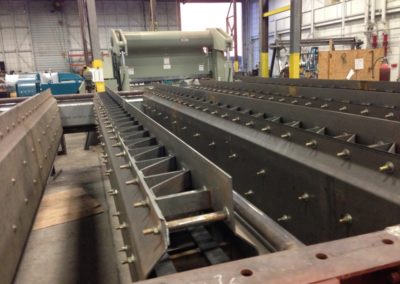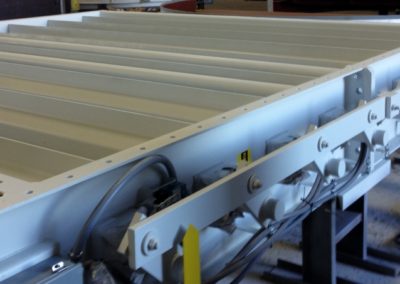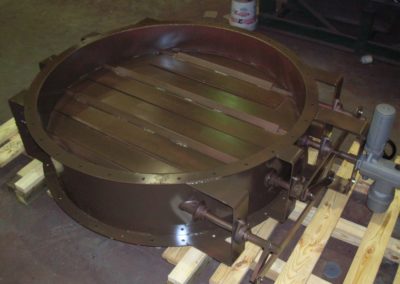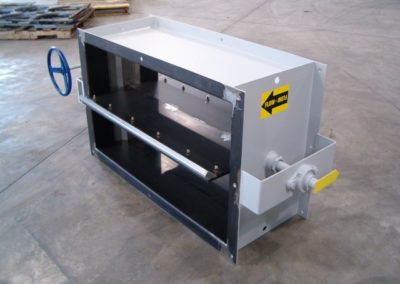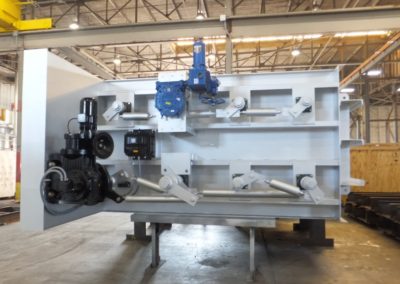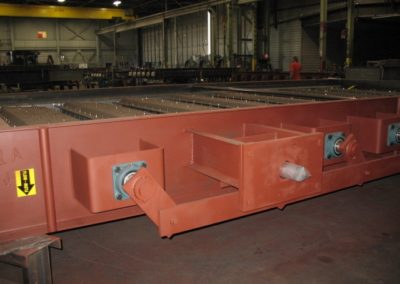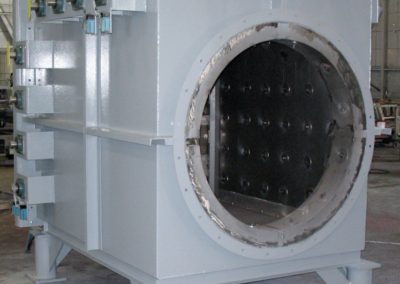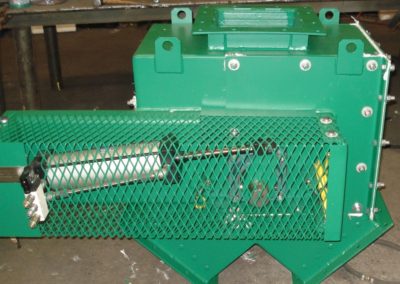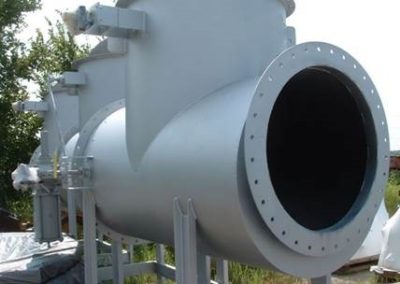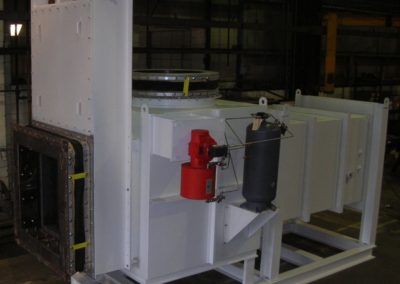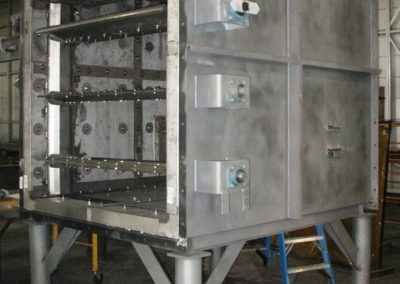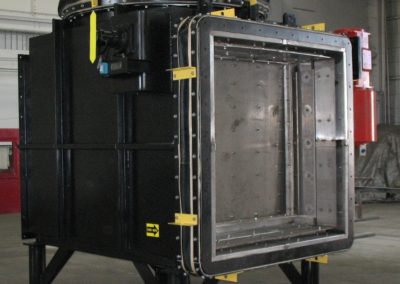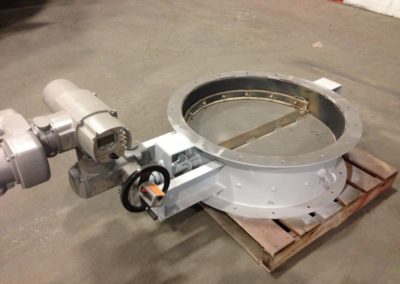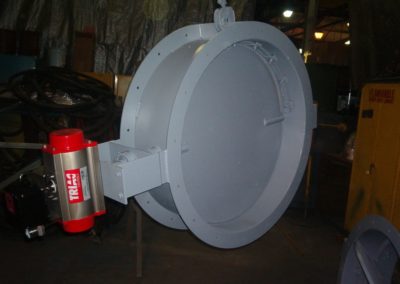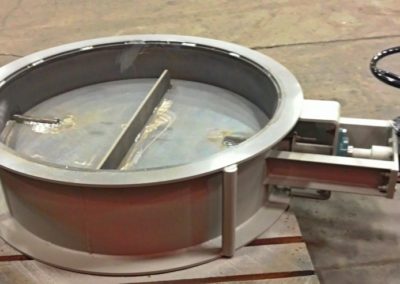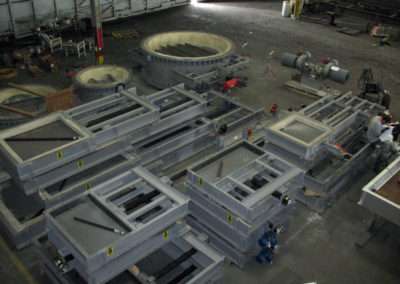Industrial Dampers Manufatured and Supplied by Fox Equipment
Louver Dampers
Louver dampers are used for two functions; control and/or isolation. There are four standard types: Parallel, Opposed, Double, and Tandem Louvers. Each louver has a row of blades that are used to control or isolate the gas flow of any process system. The key advantages of the louver damper include its fast operating speed and minimum perimeter clearance requirements. Typical heavy duty applications include: Flue Gas processing, component of CHP (combined Heat and Power) diverter system, pressure relief, airflow control, gas exhaust, and pre-spinning of duct air.
Parallel Louvers
Parallel louvers are primarily used for isolation applications. All of the blades rotate in the same direction. With the addition of blade seals, this damper can achieve better than 99% shut off. Parallel blade louvers are also used on inlet boxes of large industrial fans to promote pre-spin to the in rushing air, thus enhancing fan performance.
Opposed Louvers
Opposed louvers are used for process gas control. The louvers function by rotating adjacent blades in opposite directions. (One clockwise, the next blade counterclockwise) Operating the blades in this manner gradually decreases or increases the cross-sectional area between the blades during operation. This gradual change in area allows this louver to have reasonably good air control features.
Double Louvers
Double louvers are designed to achieve zero leakage isolation. Double louvers achieve zero leakage isolation by pressurizing the space between the two sets of louver blades with “seal air”. This “seal air” is supplied at a pressure higher than the pressure in the flue duct, creating a positive pressure environment.
Tandem dampers
Tandem dampers are designed to perform as a Double Louver Damper except instead of having “seal air” between two sets of louver blades, the “seal air” is between the two skins of the wider tandem blades. The advantage is a more compact design as well as fewer blades, bearings, shafts, etc.
Wafer Dampers /Butterfly Dampers
Wafer Dampers also known as Butterfly dampers are used in round duct applications. The advantages of this damper include the simplicity of design, quick closing capability, versatility and cost efficiency. Primarily used for flow control and low leakage functions, butterfly dampers are specified in systems that handle light particulate or clean gas. Typical applications include: system balancing, Industrial utilities, baghouses, high temp flue gas processing, refineries, and steel mills.
Guillotine Dampers / Slide Gate Dampers
Slide Gate Dampers also called Guillotine Dampers are most commonly specified when positive isolation for maintenance is the primary function of the damper and also for severe service conditions. Guillotines are classified in two styles: Low Leak and Zero Leak. Both styles are ideal for a high degree of isolation while providing low pressure drop when the dampers are in the open position. Guillotine dampers are commonly used in systems that require routine access to a duct, i.e.; maintenance, inspection, or repair. Typical heavy duty applications include: Steel mills, Power plants, cement plants, reformers, petrochemical, and heavy duty exhaust systems.
Low Leak Slide Gates
Low leak slide gates are primarily used for isolation purposes where low levels of leakage and pressure drop are required. Low Leak applications include isolation for systems that function under negative pressure or require a tight shut-off to aid in the systems process. (i.e. shaking the bags in a large bag house)
Zero Leak Slide Gates
Zero leak slide gates are used when zero-leakage isolation is required. Zero leakage isolation is accomplished by pressurizing the seal air chamber that surrounds the blade edges. When compared to a double louver, the zero leak slide gate requires less seal air and flange to flange space; therefore, it can be used in tight runs of ductwork.
Diverter Dampers
Diverter dampers are designed with one inlet and two outlets. The outlets are normally at right angles from each other. This system always allows for an escape route for the flue gas, therefore protecting any upstream equipment from bottlenecking the turbine. Diverters can be supplied in a low leak or zero leak application. They are perfect for clean applications that require low-pressure drop and good isolation. Diverter dampers are available in three configurations: louver, flap style, and Tee.
Typical applications include: Primarily for isolation/bypass applications such as waste heat recovery steam generators (HRSG) on gas turbine systems. These are designed specifically for the harsh and demanding service of these combined cycle systems. With our total product line and design/engineering capabilities, Fox Equipment is a leading provider of the complete Diverter package, including the expansion joints between the Turbine, Exhaust to HRSG and Bypass, Diverter, Bypass and HRSG Stack, Stack Silencers and HRSG Stack Isolation Dampers.
Louver Diverter Dampers
The Louver Diverter is designed to exhaust or divert the high temperature gas from a turbine to the heat recovery system or bypass system. This diverter utilizes Louver dampers on both outlets (exhaust and bypass). This system allows for outstanding flow control efficiency along with quicker response time for the diversion of gas. In the ever growing area of combined heat & power (CHP) systems, the louver diverter damper is becoming the industry choice as an extremely cost effective and efficient exhaust/bypass solution.
Flap Diverter Dampers
The flap is custom engineered to divert high-temperature exhaust gases from a gas turbine to the heat recovery boiler or bypass system. The blade pivots from one end rotating 90 degrees to close off one of the two outlets. The single blade (Flap) diverter damper is designed for improved flow distribution and sealing capability of the system. The Flap diverter damper is designed to accommodate all internal and external loads the application may require. Flap diverters can be designed to for up to 100% sealing efficiency while minimizing heat loss and pressure drop.
Tee Diverter Dampers
T-Diverter dampers are commonly used when an application requires diversion of gas to flow another direction. The individual dampers are typically mechanically linked together so when one is open the other is closed. By adding a modulation actuator, this diverter damper will allow diversion and efficient control of flow to either outlet. Tee diverters can extend the capabilities of the butterfly damper design by combining two butterfly dampers into a common tee configuration.
Radial Vane Dampers
Radial vane /VIV /IVC dampers are most commonly associated with fans handling flue gases. They provide additional flow control for fan inlets. Radial Vanes also installed as an energy efficiency fan accessory by providing pre-spin of the air into the fan. Starting the fan while the damper is in the closed position allows for a low horsepower startup. Fox Equipment supplies all radial vane dampers with a cantilevered blade design complete with two external bearings thus eliminating the need for blade support and bearings in the gas stream. Fox Equipment also has a cantilevered conical design for FD fan applications. Each damper is custom designed to fit directly to a specific fan manufacturer’s inlet.
Stack Isolation Dampers
Stack isolation dampers provide accurate airflow and isolation at extremely elevated temperatures. They function to minimize heat loss from the boiler and to protect ductwork from the elements, such as rain water. Fox Equipment designs their Stack Dampers for the toughest conditions to provide high reliability and includes several sealing options depending on the service as well as pressure relief to protect the boiler in case of system failure, blade vibration resistance, and flue gas isolation. Typical applications include the exhaust stack for Gas Turbine (GT) / Heat Recovery Systems (HRSG)
Poppet Dampers
Poppet dampers are ideal for applications that require frequent, quick cycling time and tight shut-off. They are an economical choice for a simple on-off system, providing high reliability and low maintenance over the life of the damper. Poppet dampers are used for multi-directional airflow control. They are engineered to control the reverse gas flow, outlet flow, and bypass flow of gases, in turn enhancing filtration, eliminating gas starving and reducing system wear. Fox Equipment Poppet dampers are designed with lock outs in both the open and closed positions for safe maintenance. Typical applications include: Baghouse, incinerators, and Thermal Oxidizer systems.
Tuned Mass Dampers
Fox Equipment is the industry leader in the tuned mass damper technology for steel stacks. Our engineers have contributed to the tremendous advances in tuned mass damper design that have been achieved over the past several decades. Contact Us to learn why an Fox Equipment solution is right for your project.
The tuned mass damper (TMD) or auxiliary mass damper, is a device consisting of a mass attached to a building or structure in such a way that it will vibrate at the same frequency as the structure, but with a phase shift. The mass is attached to the structure by a spring-dashpot system and energy is dissipated by the dashpot as relative motion develops between the mass and the structure.¹
Steel stacks are prone to move in a crosswind manner due to vortex shedding. Since steel stacks have very low inherent dampening, this movement is not easily stopped. Tuned Mass Dampers (TMDs) are passive, secondary vibration systems designed to increase the structural dampening of the primary system. Damping devices are attached to a chimney to increase its structural damping, thereby significantly reducing the cross-wind and along-wind vibrations, including the effects of aerodynamic interference by other nearby towers or chimneys.² The American Society of Mechanical Engineers Steel Stack Standard STS-1 prescribes the conditions under which vibration control such as a TMD is required. Fox Equipment offers Tuned Mass Dampers meeting the requirements of ASME STS-1 and CICIND Model Code for Steel Chimneys.
Like downwind loads, vortex shedding forces are the product of pressure and area. The vortex shedding pressure is proportional to the stack’s critical wind velocity and the area is obviously proportional to its diameter. The higher a stack’s critical wind velocity and diameter, the higher its vortex shedding forces. The critical wind velocity is the wind velocity at which the vortex shedding frequency matches the stack’s natural frequency.
The Tuned Mass Damper works by transferring lateral forces to the stack from a mass suspended from the top of the stack. These forces are transmitted from the mass to the stack via flexible isolators affixed between the mass and the stack. The isolators and the mass are flexible to allow “tuning” of the secondary TMD system frequency to the primary stack system.

